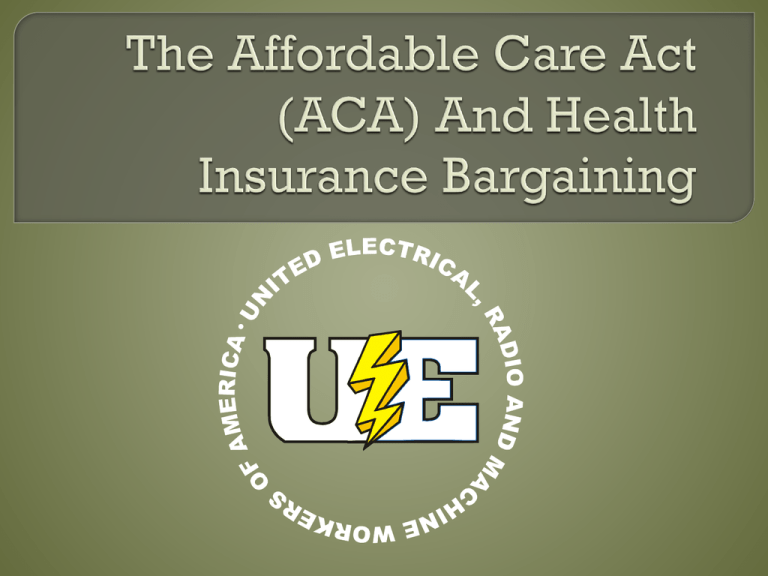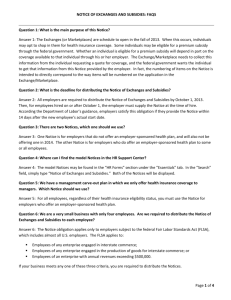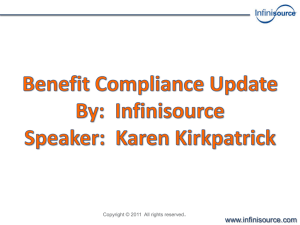ACA and Health Insurance Bargaining
advertisement

Workplaces with good insurance gravely threatened by new “excise tax” Workplaces with poor insurance or low incomes may fare better on state exchanges Everyone else continues the fight to retain benefits in even tougher circumstances No changes in plan design, providers, or new limitations Medical care providers to determine treatment, not insurance bureaucrats Choice of medical providers, including hospitals No paperwork – easy to follow plan documents Oppose cost shifting onto workers No denial based on employment status, economic status, or immigration status • Healthcare for All, UE 73rd National Convention, Chicago, IL, August 2013 Drop insurance – make workers go on exchange Ratchet down coverage to 70% or less Slash benefits where excise tax is threat Convert jobs to under 30 hours per week Contract out work to temps Provided tax credits to small employers for insuring workers Closed Medicare Part D “donut hole” Reduced cost to employers for pre-65 retirees Expanded family coverage to young adults under age 26 Mandated free preventive care under new employer-provided plans As of October 1, 2013, enrollment in exchange plans has begun 1. Develop understanding of current health insurance 2. Shops with good insurance • Use The Alliance excise tax calculator to determine if insurance at risk of falling under excise tax 3. Shops with low wages and poor insurance • Undertake survey to see if members benefit from exchange subsidies • Use either the UC Berkeley Labor Center ACA calculator, or a cell-based app like Obamacare411 to calculate membership’s potential exchange subsidies Ensure contracts set benefit threshold at 30 hours or less New restrictions on probationary periods for insurance • $400 fine on employers for period over 30 days • $600 fine if over 60 days • Insurance cannot set period longer than 90 days Illegal for bosses to retaliate for enrolling and getting subsidies on the exchanges • Add specific contractual protections (make it grievable) January 1, 2014 Beginning of exchange subsidies March 31, 2014 Beginning of individual mandate January 1, 2015 Beginning of employer mandate January 1, 2016 Small business exchanges in all states must cover employers with 50-100 employees January 1, 2017 States may allow large employers on exchange, states may opt out (for example, Vermont single payer) January 1, 2018 40% excise tax on “high value” health insurance plans begins Employer Action Less than 95% of 30+ hour workers offered insurance Workers have unaffordable employer-based coverage, enroll on exchange and qualify for subsidies Annual Fine $2,000 x (FT headcount–30) $3,000 per enrolled worker Marketplace for private health insurance plans to be purchased by individuals and small businesses Costs/coverage transparent – no waiting for rates Plan comparison/enrollment online Pooling requirements should mean no difference in rates besides age/smoking status Every state has one or more exchanges • 27 federally-run exchanges • 7 federal-state partnerships • 17 state-run exchanges Plans rated based upon the percent of medical expenses covered • Platinum (90%), Gold (80%), Silver (70%) and Bronze (60%) • Catastrophic plans for adults under 30 • For a silver plan (baseline on exchange), 70% of expenses would be covered by insurance for a typical enrollee – the last 30% would be paid in some mix of coinsurance, copays, and deductibles Individuals: • Everyone who isn’t an undocumented immigrant • Some will pay 100% of premium cost Income limits are fairly high ($92,200 for family of four) Small businesses: • Of under 50 employees in all states • 50-100 in some states (all by 2016) Employee Range Access to exchange? Special Tax Mandate? Credits? 1-24 2014 Yes No 25-49 2014 No No 50-99 2014 or 2016, depending on state No Yes 100+ After 2017, if state decides to allow No Yes Push for employer to offer access to gold or platinum plans rather than silver Don’t agree to pay a percentage of premium, due to the oldest workers potentially having premium shares three times greater than the youngest Instead, bargain to establish either a flat dollar amount for the premium share, or a percentage of total monthly wages Income Level As % of FPL Max % of Household Income for Premium 100%-133% 2% 94% 66% 133%-150% 3%-4% 94% 66% 150%-200% 4%-6.3% 87% 66% 200%-250% 6.3%-8.05% 73% 50% 250%-300% 8.05%-9.5% 70% 50% 300%-400% 9.5% 70% 33% % of Medical Reduction of Expenses OOP Max Covered Workers in lower-wage shops may gain enough exchange subsidies to make eliminating employer-provided insurance and going to exchange sensible • Particularly true for older workers and smaller employers • May need some additional compensation to make going to an exchange worthwhile Resist employer demands to eliminate insurance and go to exchange in all cases where wage is over $16.00 per hour Not covered by employer mandate: • Spouses • Pre-65 retirees • Part timers (under 30 hours) If 50%-100% of cost is picked up by employee, dropping coverage may be better Charge per Adult Charge per Child Family Max Or % of Income If Higher 2014 $95 $47.50 2015 $325 2016 $695 $162.50 $347.50 $285 $975 $2,085 1% 2% 2.5% All health plans above an annual limit subject to a 40% tax on all benefits exceeding that limit Benefit value includes sum of: • Total premium (employer & employee share) • Employer contributions to HSAs, HRAs, MSAs, and FSAs • Likely employee contributions to HSAs, MSAs, and FSAs • Supplemental health benefits, like onsite medical clinics Insurance companies plan to pass cost along in higher premiums, and employers plan to pass it along to their workers 40% Tax Above Annual Limits 2018 2019 2020+ Single – Regular Limit $10,200 CPI+1% CPI Single – High Risk/Retiree $11,850 CPI+1% CPI Family – Regular Limit $27,500 CPI+1% CPI Family – High Risk/Retiree $30,950 CPI+1% CPI Insurers may no longer offer good plans More options in self-insured workplaces to reduce costs without increasing out-of-pocket costs • Eliminating high-cost, low value providers from network, HMOs, wellness, eliminating FSAs, etc Experience may be similar to Pension Protection Act – negative change to federal law that we are limited to bargaining over the effects of If workplace’s insurance isn’t in danger of hitting excise tax, and wages are too high for exchange subsidies, it’s the same fight as always Keep in mind it’s now more expensive for the boss to eliminate our insurance Don’t let the employer use confusion to push through new massive concessions Healthcare bargaining remains difficult, but not too different until all employers are allowed on exchanges Educate and involve the membership Challenge employers to sign on to Medicare for All/Single Payer Mobilize allies by framing contract fight as part of a broader fight for healthcare for all Publicly blow the whistle on employers trying to dump workers off coverage Talk to members about real solutions to the healthcare crisis UE Website • This presentation, along with other materials and links to ACA-related documents, to be available UC Berkeley Labor Center • Best guide available with unions online Kaiser State Premium Watch • Tracking all state actions – keep watch for your own exchange Kaiser Family Foundation • General accessible information regarding healthcare reform











